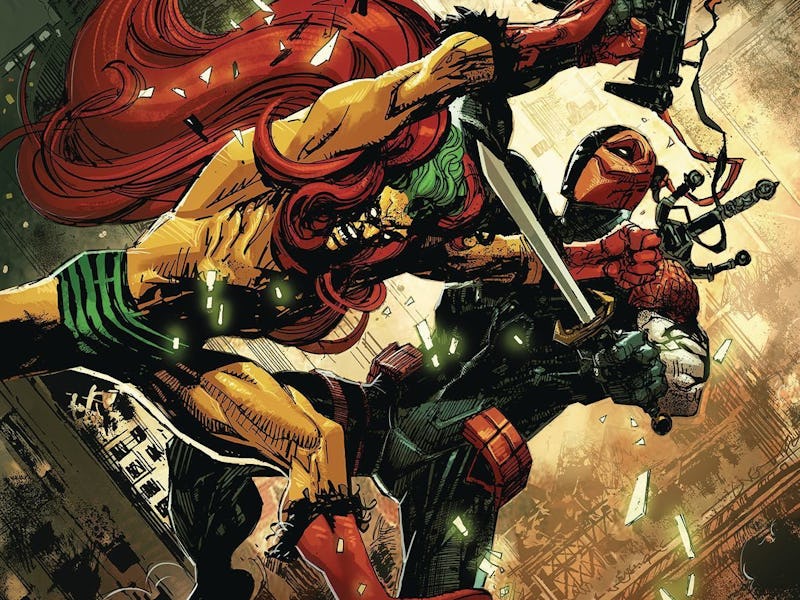Deathstroke is Gunning for Social Justice in Chicago
'Deathstroke' #11 takes Slade Wilson to the streets.

Slade Wilson, the most ruthless killer in the DC Universe, has clashed with Superman and even his own daughter in Christopher Priest’s ongoing run of Deathstroke. In this week’s issue #11, Slade makes a detour to Chicago and accepts a unique contract: He’s been hired by inner city mothers to kill every member of the city’s gangs. Violence begets violence, but through the gun-toting, sword-wielding Deathstroke, Priest explores the bits of hope in the overwhelming desperation of a proud, resilient Chicago.
Unlike better-known characters like Batman, Slade’s only motivation is to finish the job. It’s Deathstroke’s cold drive that Priest believes makes him well-suited to address the reality of gun violence. “My thinking is that if you’re going to make an anti-violence statement at DC Comics, what better place to make it than in Deathstroke, a book that glorifies violence?” Priest tells Inverse. “I think violence is terrible and I think that in too many instances we try to solve our problems with guns and bombs rather than talking to each other.”
Deathstroke issue #11 begins on a snowy night in Austin, a neighborhood in Chicago, with a 12-year-old boy’s body lying on the sidewalk. It’s a crime scene. A chain-smoking detective talks to Jack Ryder, a reporter, citing actual statistics of gun violence (the comic contains citations in word boxes). They try to separate fact from rumor. Fact: Chicago is plagued with gun violence. Rumor: Deathstroke is trying to end it.
Cover of 'Deathstroke' #11
Ryder, a former Gotham City talk show host seeking to reestablish his credibility, returns to the DC Universe. In his investigation, Ryder comes face to face with a “sad sorority” of mothers whose sons have become statistics. They’ve pooled their savings to hire Deathstroke to get rid of the gangs, permanently. It’s a brutal means to a brutal end, and Priest — through his characters and dialogue — make it clear this is no solution at all. But if there was one, it’s likely this comic wouldn’t exist.
Though Priest offers his opinions on gun violence in “Chicago,” he’s careful to distance his voice from Slade’s, whom he believes isn’t a cool, ambiguous anti-hero but a villain. “The guy I’m writing is a villain, plain and simple,” says Priest. “He is completely indifferent to what’s going on in Chicago. A job is a job.” At the end of the issue, Deathstroke offers a harsh, uncomfortable truth about inner-city violence. “That’s Deathstroke talking,” Priest assures. “That’s not [me] talking.”
A Baptist minister born and raised in Queens, Priest began his comics career in 1982 before retiring in 2005. He returned last year for Deathstroke, which he accepted only if he could write on his terms. This meant reinventing Deathstroke, a violent book for a thrill-seeking readership, into a different beast. “Deathstroke is now a book that is not about violence but about the consequences of violence, and the impact that has on Slade Wilson,” says Priest.
Preview of 'Deathstroke' #11
Priest says he’s disinterested in the “heightened reality” of most popular comic books today, which makes his issue #11 of Deathstroke all the more stark. “I’m a fish out of water,” Priest says. “When you read comics, it’s Saturday morning animation. Maybe that’s what comics are now, maybe that’s what’s selling, maybe that’s what fans want, but that’s not my style.”
With its tackling of real violence in a diverse superhero universe, Deathstroke #11 is also a thesis for Priest on the genre. If superheroes were real, could they actually prevent violence? “If superheroes really did exist, they would have 80 percent fewer fights. All you would need is one super-fight to establish, ‘Don’t screw with Superman,’ and that would be it.”
“I don’t think it would really bring more violence,” adds Priest. “I think they might bring more fascism. They may be tempted to fix us. God knows we need fixing.”
Deathstroke #11 is available in comic book stores today.